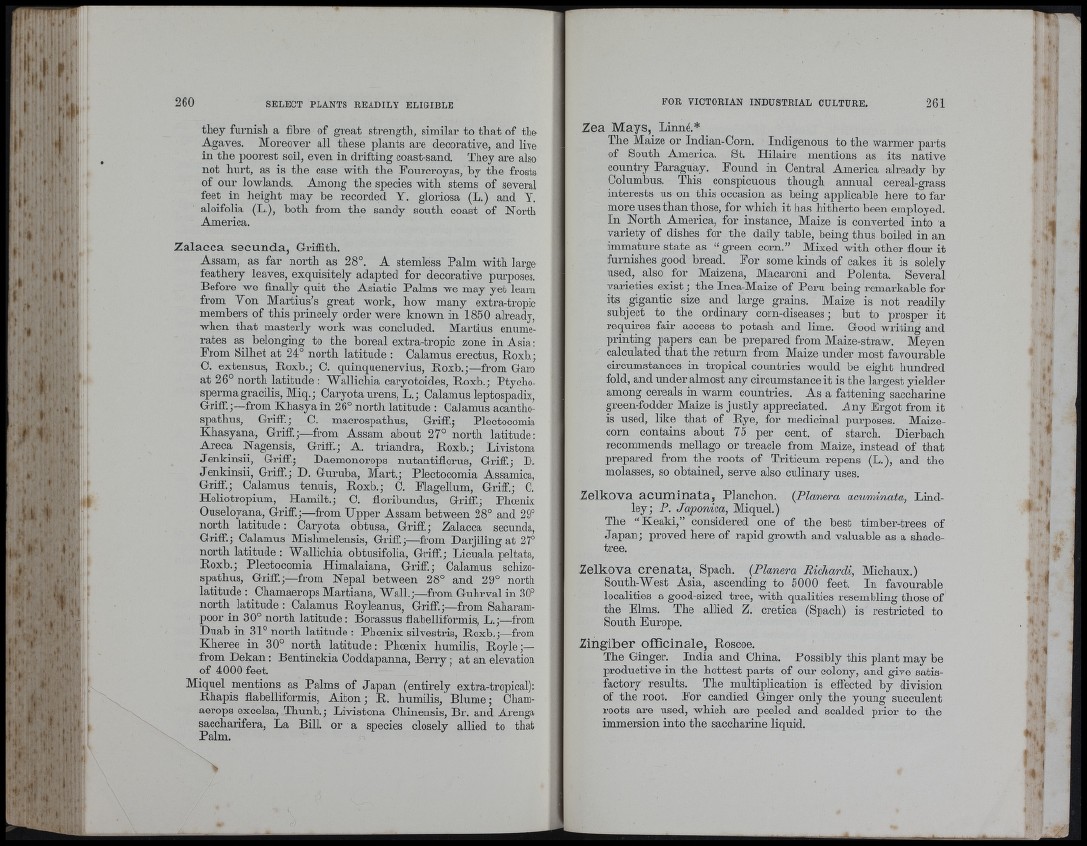
} i
* í T
II f
irí?
they furnish a fibre of great strength, similar to that of the
Agaves. Moreover all these plants are decorative, and live
in the poorest soil, even in drifting coast-sand. They are also
not hurt, as is the case with the Fourcroyas, by the frosts
of our lowlands. Among the species with stems of several
feet in height may be recorded Y. gloriosa (L.) and Y.
aloifolia (L.), both from the sandy south coast of North
America.
Zalacca secunda, Griffith.
Assam, as far north as 28°. A stemless Palm with large
feathery leaves, exquisitely adapted for decorative purposes.
Befoi’e we finally quit the Asiatic Palms we may yet learn
from Yon Martins’s great work, how many extra-tropic
members of this princely order were known in 1850 already,
when that masterly work was concluded. Martius enumerates
as belonging to the boreal extra-tropic zone in Asia:
From iSilhet at 24° north latitude : Calamus erectus, Boxb.;
C. extensus, Boxb.; C. quinquenervius, Boxb.;—from Garo
at 26° north latitude : Wallichia caryotoides, Roxb.; Ptychosperma
gracilis, Miq.; Caryota nrens, L.; Calamus leptospadix,
Griffi;~from Khasya in 26° north latitude : Calamus acantho-
spathus, Griff.; C. macrospathus, Griffi; Plectocomia
Khasyana, Griffi;—from Assam about 27° north latitude:
Areca Nagensis, Griffi; A. triandra, Roxb.; Livistona
Jenkinsii, Griff.; Daemonorops nutantifioi’us, Griffi; B.
Jenkinsii, Griffi; D. Guruba, Mart.; Plectocomia Assamica,
Griffi; Calamus tenuis, Roxb.; C. Flagellum, Griffi; C.
Heliotropium, Hamilt.; C. fioribundus, Griffi; Phoenix
Ouseloyana, Griff“.;—from Upper Assam between 28° and 29°
north latitude: Caryota obtusa. Griff.; Zalacca secunda,
Griff.; Calamus Mishmelensis, Griff.;—from Darjiling at 27°
north latitude : Wallichia obtusifolia, Griff.; Licúala peltata,
Roxb.; Plectocomia Himalaiana, Griff.; Calamus schizo-
spathus, Griff.;—from Nepal between 28° and 29° north
latitude : Chamaerops Martiana, Wall.;—from Guhrval in 30°
north latitude : Calamus Royleanns, Griff.;—from Saharam-
poor in 30° north latitude : Borassus flabelliformis, L.;—from
Duab in 31° north latitude : Phoenix silvestris, Roxb,;—from
Kheree in 30° north latitude : Phoenix humilis, Royle;—
from Dekan : Bentinckia Coddapanna, Berry ; at an elevation
of 4000 feet.
Miquel mentions as Palms of Japan (entirely extra-tropical):
Rhapis flabelliformis, A ito n ; R. humilis, Blume; Chamaerops
excelsa, Thunb.; Livistona Chinensis, Br. and Arenga
saccharifera. La Bill, or a species closely allied to that
Palm.
Zea Mays, Linné.*
The Maize or Indian-Corn. Indigenous to the warmer parts
of South America. St. Hilaire mentions as its native
country Paraguay. Found in Central America already by
Columbus. This conspicuous though annual cereal-grass
interests us on this occasion as being applicable here to far
more uses than those, for which it has hitherto been employed.
In North America, for instance. Maize is converted into a
variety of dishes for the daily table, being thus boiled in an
immature state as “ green corn.” Mixed with other flour it
furnishes good bread. For some kinds of cakes it is solely
used, also for Maizena, Macaroni and Polenta. Several
varieties exist ; the Inca-Maize of Peru being remarkable for
its gigantic size and large grains. Maize is not readily
subject to the ordinary corn-diseases ; but to prosper it
requires fair access to potash and lime. Good writing and
printing papers can be prepared from Maize-straw. Meyen
calculated that the return from Maize under most favourable
circumstances in tropical countries would be eight hundred
fold, and under almost any circumstance it is the largest yielder
among cereals in warm countries. As a fattening saccharine
peen-fodder Maize is justly appreciated. Any Ergot from it
is used, like that of Rye, for medicinal purposes. Maize-
corn contains about 75 per cent, of starch. Dierbach
recommends mellago or treacle from Maize, instead of that
prepared from the roots of Triticum repens (L.), and the
molasses, so obtained, serve also culinary uses.
Zelkova acuminata. Planchón. {Planera acuminata, Lindley;
P. Japonica, Miquel.)
The “ Keaki,” considered one of the best timber-trees of
Japan; proved here of rapid growth and valuable as a shade-
tree.
Zelkova crenata, Spach. {Planera Richardi, Michaux.)
South-West Asia, ascending to 5000 feet. In favourable
localities a good-sized tree, with qualities resembling those of
tke Elms. The allied Z. crética (Spach) is restricted to
South Europe.
Zingiber officinale, Roscoe.
The Ginger. India and China. Possibly this plant may be
productive in the hottest parts of our colony, and give satisfactory
results. The multiplication is effected by division
of the root. Eor candied Ginger only the young succulent
roots are used, which are peeled and scalded prior to the
immersion into the saccharine liquid.
b \, '